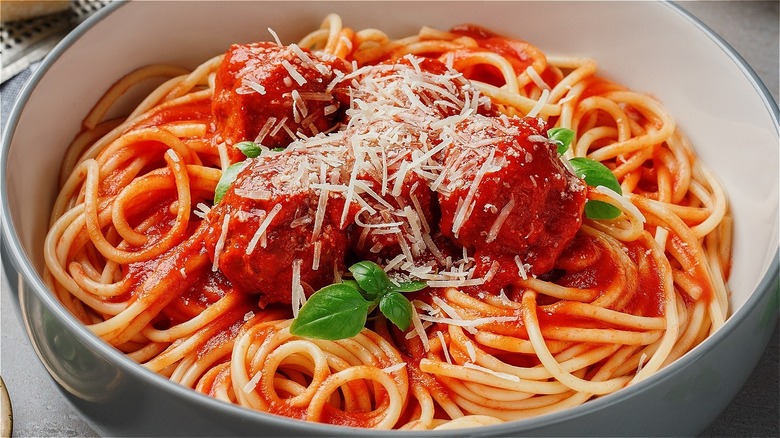This Is The Best Time To Combine Spaghetti With The Sauce
In any good marriage — peanut butter and jelly, milk and cookies, spaghetti and sauce — there needs to be a balance. Too much peanut butter, and the sandwich is dry. Too much jelly, and it's an overly sweet, soggy mess. The same holds for spaghetti and sauce. The right balance of sauce to pasta, as well as combining them at the right time, can be the difference between mere sustenance and a meal so good you hope it never ends.
Whether you call it gravy or sauce, a pound of pasta requires 24 ounces of red sauce, or ¼ to ½ cup per 1-cup serving of pasta, according to Barilla. Oily sauces like pesto can be used more sparingly, a little more than ½ cup of sauce per pound of pasta, and creamy alfredo sauce even less. Although sauciness is a personal preference, chef Sara Jenkins of Porchetta in New York City described the perfect amount of sauce for Epicurious: "After you've eaten the pasta, there should be just enough sauce left in the bowl to swipe a small piece of crusty bread through."
While images of a bowl of spaghetti topped with a ladle of sauce may look nice in commercials, authentic Italian pasta dishes aren't served that way. Whether it's fresh or dried pasta, combining the proper amount of sauce at the right time is a technique that can transform your next pasta dish into restaurant-quality pasta al dente.
Finish cooking the pasta in the sauce
To marry spaghetti and sauce into a single dish, coating each noodle with delicious sauce, it's essential to combine the two components while the pasta is still cooking. As Rachael Ray described in a recent Instagram post, pasta should be undercooked by a few minutes shy of al dente when removed from the boiling water. Before straining your pasta, reserve a cup of starchy pasta water, then add the pasta directly to your sauce, keeping in mind the correct amount of sauce per pound of pasta. We don't want to drown the pasta!
Continue to cook the pasta for a few minutes in the simmering sauce, using tongs to move the pasta around and adding a ladle or two of pasta water to bind everything together, as chef Devan Cameron explained to Mashed. The pasta water creates a silky sauce, especially if you've made a creamy or oil-based pasta sauce. According to Serious Eats, the pasta will cook slower in the sauce versus boiling water, so this method reduces the chances of overcooking your pasta, too.
Due to "carryover cooking," pasta will continue to cook for a few minutes after you remove it from its cooking source, so remember to take it off the heat before it's perfectly al dente. Pasta al dente should still be white in the very center when you bite into it, not crunchy or mushy but with a satisfying resistance. Buon appetito!

